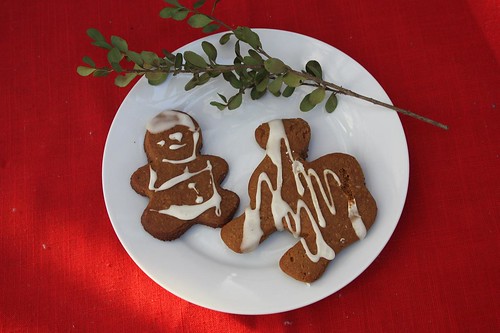Of course I had to make gingerbread men for Christmas. You can’t be halfway through a book on gingerbread and then pass up the obvious opportunity to bake it; it simply wouldn’t be allowed. And, of course, I’m no longer happy with the recipes I had at hand. So I came up with a recipe with a genuinely historical flavor but the tenderness and richness we expect from a Christmas cookie.
Here’s the challenge: The gingerbread that most Americans ate a couple hundred years ago was pungently spiced (heavily but not exclusively with ginger) and redolent of molasses, but also quite dry. Today’s recipes for gingerbread men are a direct descendant of that gingerbread, but over two hundred years they’ve become less spicy, richer, and sweeter, with molasses becoming only an accent. Amelia Simmons, in 1798, called for molasses as the only sweetener, two tablespoons of ginger, and only two tablespoons of butter to a pound of flour. At the other end of that spectrum is (no surprise here) Martha Stewart, whose gingerbread cookies have a three-to-one ratio of sugar to molasses, only a teaspoon and a half of ginger, and two sticks of butter to just under a pound of flour. They also have grated fresh ginger, which is a nice accent but decidedly twenty-first century. And while they’re wonderful cookies, all that butter makes them extremely fussy to roll out, especially when your assistant is an impatient seven year-old.
Unfortunately, the parts of each style that I like never met in the middle. By the time richer cookies became the norm, spices had become more muted, and molasses was being pushed to the side.
This recipe, I think, has the best of both eras. I kept Simmons’ spices essentially intact, because I’ve grown attached to that early American flavor profile. I added a little sugar, though, and an egg to provide tenderness as well as structure, and split the difference on the butter. The result is a cookie that’s rich enough for Christmas but still fundamentally gingerbread — and, yes, well-enough structured for a seven year-old to roll out and cut.
Recipe: Gingerbread men
A quick word about the technique. I use the old method of rubbing the butter into the flour by hand, because it’s less messy than creaming. You could cream the butter and sugar if you prefer. It makes no discernible difference in the finished cookie; the value of creaming butter is the air you beat in, but that air will be crushed out when you roll out the dough. So use whichever technique you find easier.
Ingredients
- 3 cups all-purpose flour
- 2 tablespoons ground ginger
- 1 tablespoon cinnamon
- 2 teaspoons allspice
- 1/2 teaspoon salt
- 1 teaspoon baking soda
- 1/2 cup (1 stick) butter
- 1/3 cup dark brown sugar
- 2/3 cup molasses (see note)
- 1 egg
Technique
- In a large bowl, whisk together the flour, spices, salt, and baking soda.
- Cut the butter into small pieces and rub it into the flour with your fingers, then rub in the sugar. Stir in the egg thoroughly with a fork. Warm the molasses slightly to make it more easily stirred — 30 seconds in the microwave will do — and combine with a fork until the mixture forms a dough. (Alternately, cream the butter and sugar with a mixer, then beat in the egg and molasses, and fold in the dry ingredients.) Chill the dough for an hour or two until it can be rolled easily.
- Roll the dough about 1/4 inch thick (or thicker, if you like, for larger cookies) and cut out in shapes as you please. Bake on greased cookie sheets at 350°F until the edges are set and the centers are barely firm. The timing will vary with thickness, but I found 8 minutes enough for a 1/4-inch-thick cookie.
Fancy modern technique
Whisk the flour, spices, salt, and soda together in a medium bowl. Cream the butter, sugar, and molasses; then beat in the egg. Stir in the dry ingredients and proceed with step 3, above.
Notes
- If you like, you can frost the cookies once they’ve cooled with a mixture of powdered sugar and fresh orange or lemon juice. If the cookies are still warm, the frosting will melt into a sort of glaze, which is also nice.
- I used a medium-grade molasses (see my earlier discussion of molasses), but if you’re going to frost the cookies, you might want to try a more robust brand like Brer Rabbit. This is not an especially sweet cookie, and the frosting makes it a good deal sweeter, even if you only drizzle it on.
